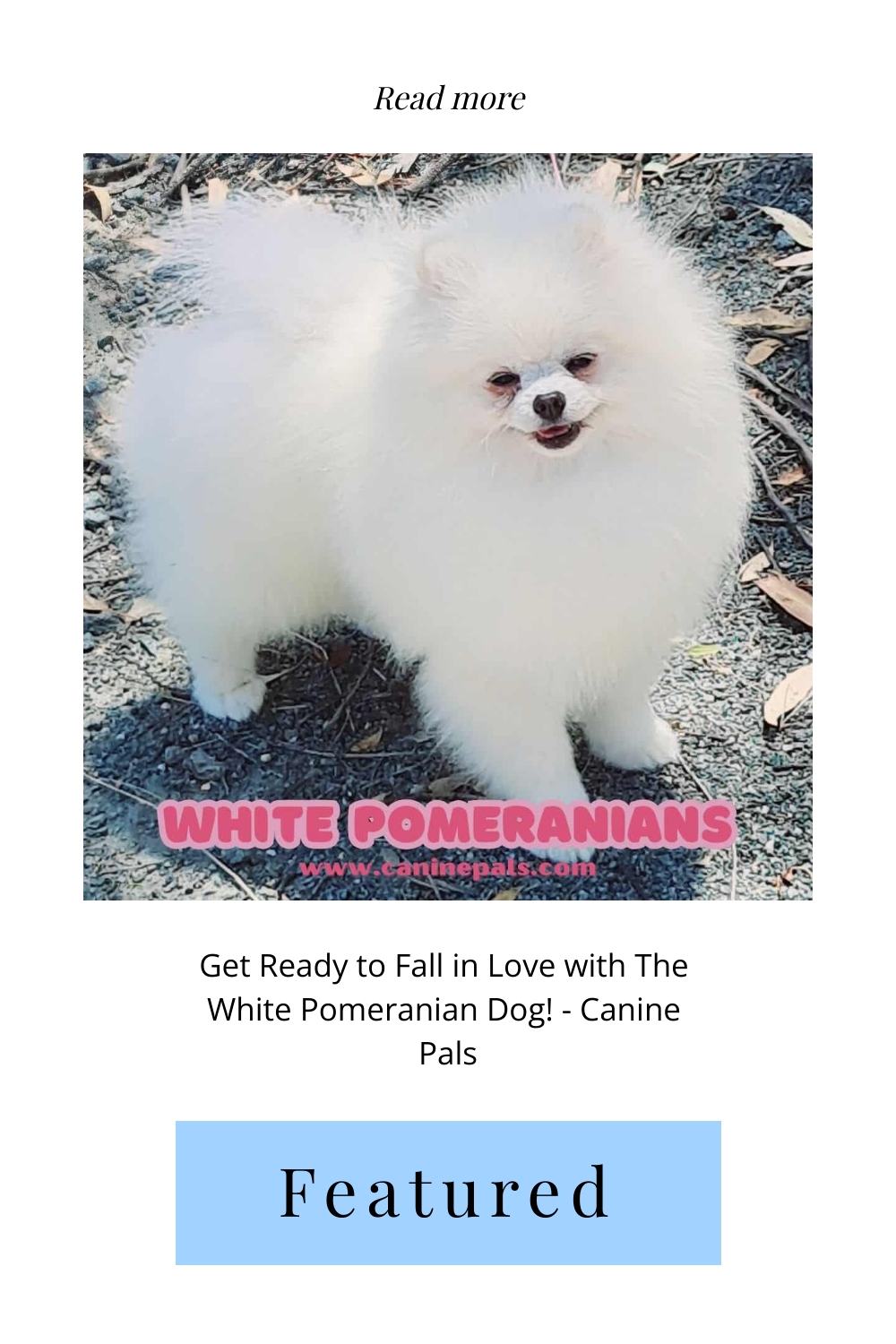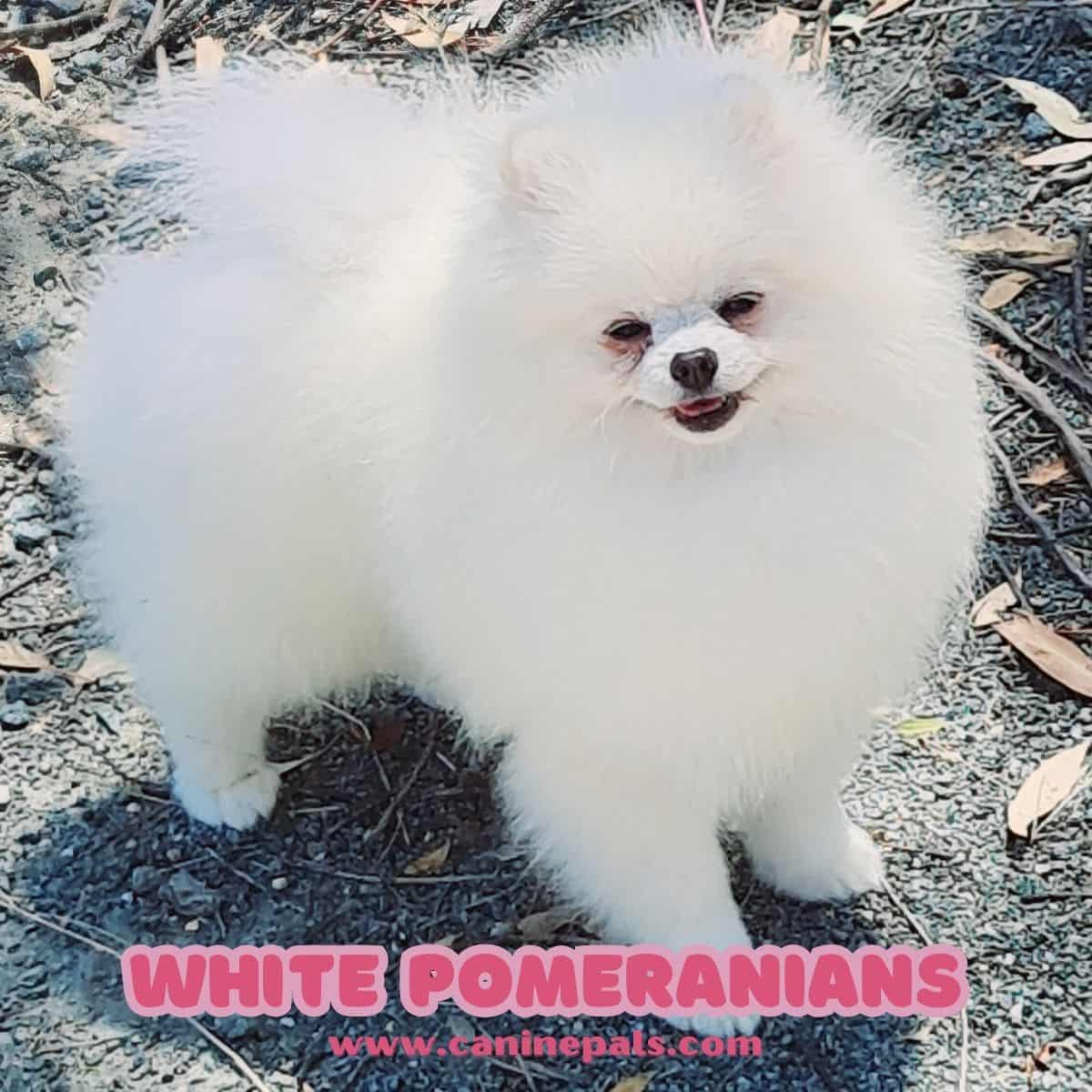Last Updated on March 20, 2024 by Denise Leo. Post first published on February 3, 2024.
If you’re looking for a precious pup that will surprise you each day with its adorable personality, look no further than the white Pomeranian!
From their fluffy white coats to their unique, playful spirit, there’s nothing quite like these cuties. White Pomeranians are beautiful, unique, toy-sized dogs that are becoming increasingly popular among dog lovers.
As their name suggests, these dogs have a white coat that is soft and fluffy, making them look like little balls of cotton. While Pomeranians are already a beloved breed, the white color variety has a unique charm that sets them apart.
White Pomeranian dogs have a rich history; where they were initially bred to be large sled dogs, but they were eventually made smaller and more suitable for life as companion animals through selective breeding.
White Pomeranians are known for their small size, playful personality, and adorable looks. Knowing what to expect is essential to add a White Pomeranian to your family.
The White Pomeranian, a solid white gem among small breeds, captivates with its stunning coat and spirited personality. This breed type is renowned not only for its distinctive solid white color but also for the quality of its lush, fluffy coat that demands regular grooming to maintain its brilliance.
Ideal for families, including those with young children, White Pomeranians exhibit a gentle and affectionate demeanor, making them perfect companions. However, prospective owners should be aware of the “small dog syndrome,” a behavioral issue where the small Pomeranian might try to assert dominance if not properly trained and socialized from an early age. Early and consistent training is crucial to nurture a well-behaved and friendly pet.
Pom puppies, especially the White Pomeranian variety, go through a phase known colloquially as the “puppy uglies,” their coat may appear patchy as they transition from their puppy fur to their adult coat. This phase is temporary, and with patience, owners will see their pup transform into the fluffy, elegant dog that the breed is known for.
The solid white color of these Pomeranians makes them particularly sought after, contributing to their appeal as a desirable breed type. Despite their small size, White Pomeranians have a big heart and an even bigger personality, making them a joyous addition to any family, especially those with young children looking for a small, loving companion.
These dogs have unique characteristics that set them apart from other breeds, and they must be prepared for their needs. In this article, we’ll explore everything you need to know about White Pomeranians, from their history and physical characteristics to their temperament and health concerns.
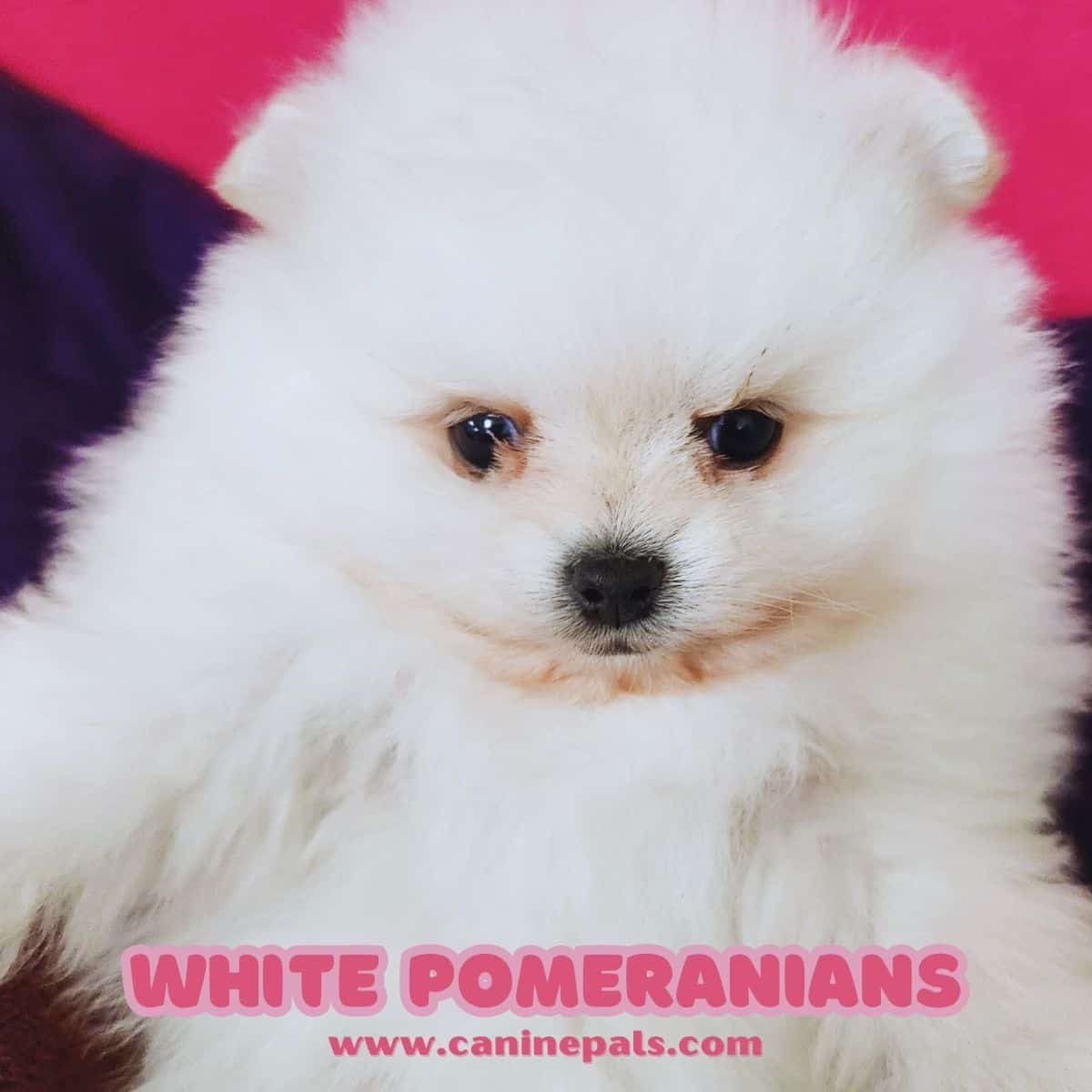
Key Takeaways
- White Pomeranians are a unique and beautiful color of the Pomeranian dog.
- These dogs have a rich history, originating from Germany. They developed as a small dog breed in the United Kingdom, where they were selectively bred to be smaller and more suitable companion animals.
- Like all white dogs, white Pomeranians have specific needs for grooming, exercise, and health, and it’s essential to be prepared for these needs before adding one to your family.
- Clear creams are often mistaken for a white dog. White Poms often go through color changes. White baby Pomeranians may be clear creams adults.
History of White Pomeranians

As a proud owner of a White Pomeranian, I was curious to learn more about the breed’s history. Through my research, I discovered some fascinating facts about White Pomeranians.
The earliest records of White Pomeranians date back to the 18th century in England. Paintings from this time featured both White Pomeranians and Poms with mixed colors. Notably, a painting requested by the Prince of Wales, King George IV, depicted him and his pet Pomeranian, Fino, in 1791—many of the paintings and prints from the 18th century feature Pomeranians of various colors and sizes.
The Pomeranian breed is believed to have originated in the Pomerania region, which is now part of Germany and Poland. The Spitz breed is one of the oldest dog breeds, and the Pomeranian is a descendant of this breed.
The Pomeranian breed was initially larger and used as working dogs. However, through selective breeding, the breed was gradually reduced in size to become the toy breed we know today.
Queen Victoria played a significant role in popularizing the Pomeranian breed. She fell in love with the breed after meeting a Pomeranian during a visit to Florence, Italy, in 1888.
Queen Victoria imported several Pomeranians from different parts of the world and bred them to develop the toy breed as we know it today. She also exhibited her Pomeranians at dog shows, which helped to increase their popularity.
The Pomeranian breed was formally recognized by the American Kennel Club in 1900. Since then, the breed has become increasingly popular, with White Pomeranians being one of the most sought-after colors.
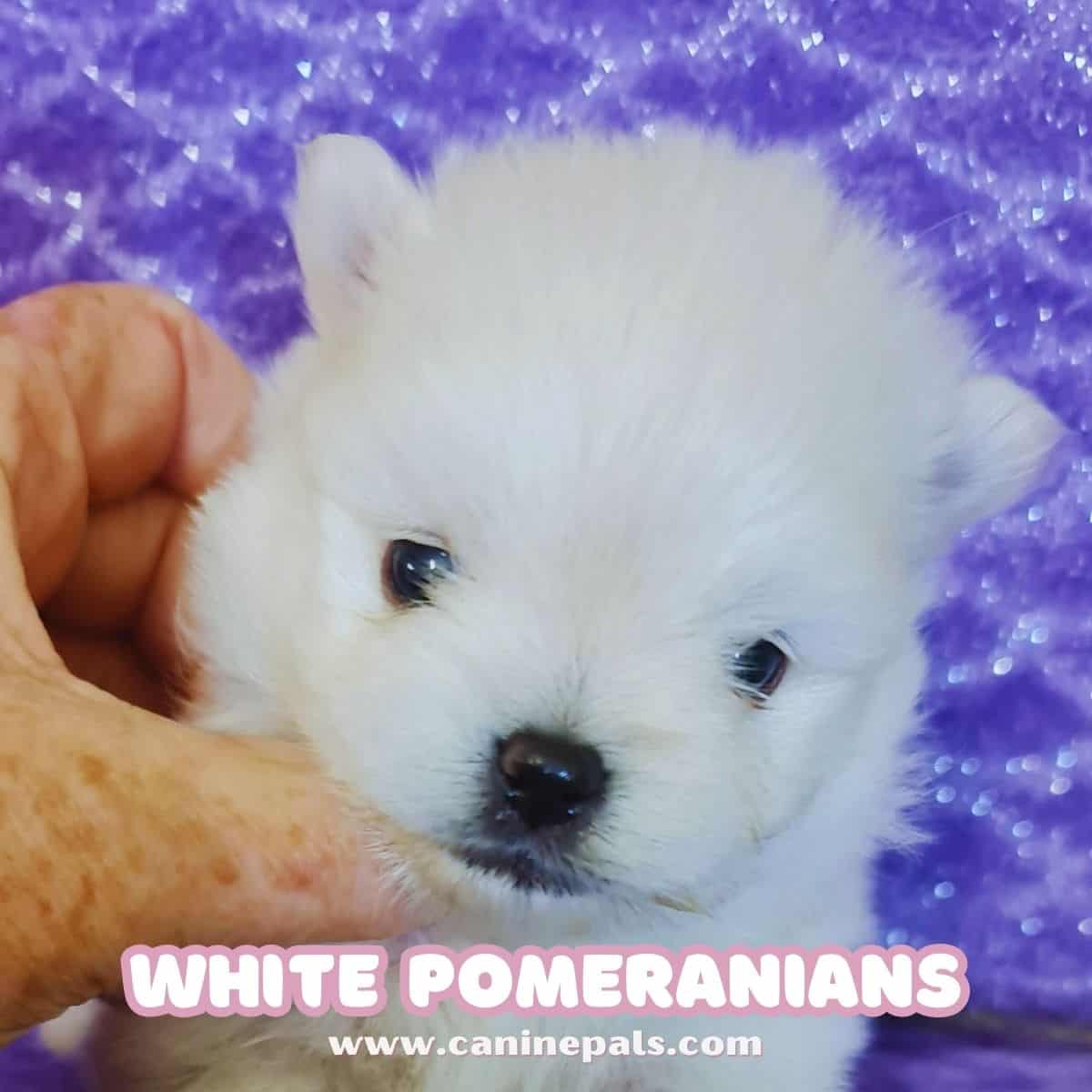
Physical Characteristics of White Pomeranians
The Pomeranian is a toy breed, standing 8-11 inches tall and weighing between 3-7 pounds. Despite their small size, they are an active breed and are well-proportioned.
One of the most striking features of Pomeranians is their double coat. Their coat is long, fluffy, and soft to the touch. It has a thick undercoat and a longer outer coat of guard hairs. This double coat helps to protect them from the cold and provides insulation in the winter months.
White Pomeranians have dark eyes that are almond-shaped and set well apart. Their eyes are one of their most expressive features, often described as intelligent and alert. The White Pomeranian should have a pure white coat.
This snowy white color is highly sought after by many dog lovers. However, it’s important to note that some Pomeranians may be prone to black skin disease, which can cause their skin to turn black in certain areas.
A white puppy Pomeranian is a beautiful dog with distinctive physical characteristics. Their fluffy coats, dark eyes, and snow-white fur make them stand out in a crowd.
Temperament and Personality of White Pomeranians
As an owner of a white Pomeranian, I can confidently say that they have a delightful temperament and personality. They are outgoing, affectionate, energetic, and happy dogs that make excellent family pets.
White Pomeranians are known for their playful and lively nature. They love to play and run around, making them great companions for children and adults. Canine experts agree these dogs are easy to train, making them perfect for novice pet owners.
One of the most endearing traits of white Pomeranians is their affectionate nature. They love to be around their owners and crave attention and affection. They are known to be loyal and protective of their owners, which makes them excellent watchdogs.
White Pomeranians are also very energetic dogs. Daily exercise is vital to maintain your pet’s good health and happiness. They love to go for walks, play fetch, and run around in the backyard. However, it’s important to note that they are small dogs and should not be over-exercised.
White Pomeranians have excellent temperaments and personalities. They are outgoing, affectionate, energetic, and happy dogs that make great family pets. If you are considering getting a dog, a white Pomeranian is worth considering.
Grooming and Exercise for Pure White Pomeranians
As an owner of a white Pomeranian, I know how important it is to keep their coat clean and healthy. White Pomeranians require regular grooming to maintain luxurious coats and prevent tear stains. Here are some tips for grooming and exercise that I have found helpful:
Grooming
- Brush white Pomeranian double coats at least once daily to prevent matting and tangling. Use a slicker brush, pin brush, and comb to remove loose fur and prevent mats.
- Bathe your white Pomeranian every 4-6 weeks to keep its coat clean and shiny. Use a gentle shampoo and conditioner that is specifically designed for dogs. Rinse thoroughly to prevent any residue from building up on their coat.
- Dry your white Pomeranian’s coat thoroughly after bathing to prevent moisture from getting trapped in their fur. Towel dry first, then use a blow dryer on low heat to dry their coat completely.
- Trim your white Pomeranian’s nails regularly to prevent them from becoming too long and causing pain and discomfort. Use a sharp nail clipper, and be careful not to cut the quick.
- Clean your white Pomeranian’s ears regularly to prevent any infections. Use a gentle ear cleaner and a makeup pad to wipe away dirt or wax.
Exercise
- White Pomeranians are energetic dogs that require regular exercise to stay healthy and happy. Take your white Pomeranian for a daily short walk or play with them in the backyard.
- Provide your white Pomeranian with plenty of toys to keep them entertained and active. Puzzle toys and chew toys are great for mental stimulation and dental health.
- Small dogs like the Pomeranian do not require lots of exercise.
- Avoid over-exercising your white Pomeranian, as they are prone to respiratory issues. Monitor their breathing and take breaks when necessary.
- Consider taking your white Pomeranian to obedience classes or agility training to provide them with mental and physical stimulation.
Tear Stains
White Pomeranians are prone to tear stains, which can be unsightly and uncomfortable for your dog. To prevent tear stains, try the following:
- Keep your white Pomeranian’s face clean and dry. Use a clean, damp cloth to wipe away any tears or debris.
- Avoid feeding your white Pomeranian foods high in salt or preservatives, as these can contribute to tear staining.
- Consider using a tear stain remover product that is specifically designed for dogs. These products can help to remove tear stains and prevent them from recurring.
- Provide bottled water instead of tap water for drinking.
- Ass one teaspoon of apple cider vinegar daily to the dog’s food.
- Check with your vet if the staining is excessive.
Overall, grooming and exercise are essential aspects of white Pomeranian care. By following these tips, you can help to keep your white Pomeranian healthy, happy, and looking their best.
Health Concerns for White Pomeranians
Unfortunately, like all dogs, white Pomeranians are prone to particular health concerns that we must be aware of. Here are some of the most common health issues that white Pomeranians face:
Hypoglycemia
Hypoglycemia is a condition that affects many toy breeds, including white Pomeranians. It occurs when a dog’s blood sugar drops too low, which can cause weakness, lethargy, and even seizures. As a white Pomeranian owner, you must feed your dog high-quality food and ensure they eat regularly throughout the day. You must contact your veterinarian immediately if you notice any signs of hypoglycemia, such as stumbling or shaking.
Patellar Luxation
Patellar luxation, or a dislocated kneecap, is common in toy breeds like white Pomeranians. This occurs when the kneecap slides out of place, causing pain and discomfort for your dog. If your white Pomeranian is limping or seems to be in pain, it’s essential to take them to the vet for an examination.
Tracheal Collapse
White Pomeranian puppies are also prone to tracheal collapse, which occurs when cartilage rings in the windpipe weaken and collapse. This can cause coughing, wheezing, and difficulty breathing. Be vigilant and act quickly if you observe any signs of tracheal collapse, such as a honking cough or difficulty breathing. You must seek veterinary care immediately.
Hypothyroidism
Hypothyroidism is a condition that can cause a range of symptoms in white Pomeranians, including weight gain, lethargy, and skin issues. If you notice these symptoms, you must take your dog to the vet for an examination.
In conclusion, as a white Pomeranian owner, it’s essential to be aware of the health concerns that your furry friend may face. By watching for these common issues and seeking veterinary care when needed, you can help ensure that your white Pomeranian stays happy and healthy for years.

Breeding and Price of White Pomeranians
Breeding white Pomeranian puppies can be challenging and requires much effort and expertise. Reputable dog breeders carefully select their breeding pairs to ensure that they produce healthy and high-quality puppies.
They also prove their dogs in the show to ring before breeding, conduct genetic testing to identify potential health conditions and avoid breeding dogs with genetic defects.
White Pomeranians are not a separate breed but a color variation of the Pomeranian breed. Their price can vary depending on various factors, including location, sex, age, breeder reputation, and the puppy’s lineage. The average cost of a white Pomeranian puppy can range from $3,000 to $9,000.
It’s important to note that the price of a white Pom pup should not be the only consideration when choosing a breeder. Reputable preservation breeders prioritize the health and well-being of their dogs and puppies above profit.
They provide their dogs with proper nutrition, exercise, and veterinary care, and they socialize their puppies from a young age to ensure they are well-adjusted and friendly.
When looking for a white Pomeranian breeder, it’s essential to do your research and choose a reputable breeder who is transparent about their breeding practices and provides health guarantees for their puppies. You can also check with the national breed club or the breeder’s section of Pomeranian headquarters for a list of breeders in your area.
Breeding white Pomeranians requires expertise and dedication, and reputable breeders prioritize their dogs’ health and well-being. While the price of a white Pomeranian can be high, it should not be the only consideration when choosing a breeder.
Get the best possible white Pomeranian puppy by putting in the effort to research and choose a reputable breeder who prioritizes the health and welfare of their dogs.
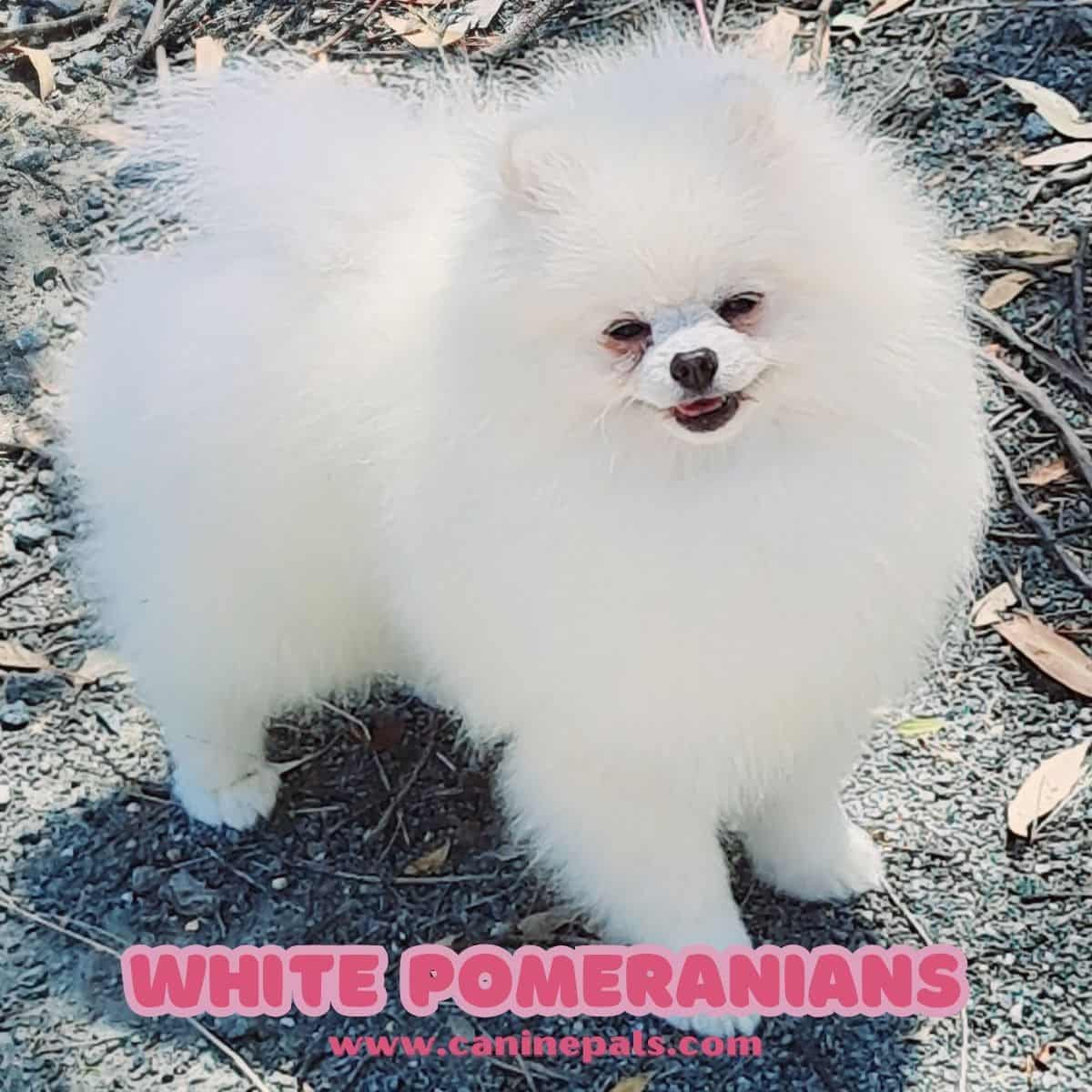
The Popularity of White Pomeranians
These cute and fluffy dogs belong to the toy breed category and are known for their small size and adorable appearance. True white Pomeranians are rare and highly sought after. They are known for their snow-white coat, black eyes, and noses.
The breed standard requires adult white Pomeranians to have black points, including black eye rims, nose, lips, and paw pads. White Pomeranian puppies are born with all pink points and gradually develop their black points as they age.
The popularity of white Pomeranians can be attributed to their charming and affectionate nature, making them great companions for families, singles, and seniors. They are also well-suited for city and apartment living due to their small size and adaptability.
As one of the original colors in this dog breed, white Pomeranians have gained recognition from various kennel clubs, including the UK Kennel Club, American Kennel Club, Australian National Kennel Club, Canadian Kennel Club, Federation Cynologique Internationale, New Zealand Kennel Club, and United Kennel Club.
However, it is essential to note that owning a white Pomeranian can be expensive. Responsible breeders must be careful during the breeding process to produce true white Pomeranians, which can take years. As a result, the price of white Pomeranians can be higher than that of other Pomeranian colors.
The popularity of white Pomeranians can be attributed to their charming and affectionate nature, adaptability, and rarity. While they can be expensive, they make great pets for those looking for a loyal and loving companion.
Unique Facts about White Pomeranians
An interesting fact about White Pomeranians is that this color is one of the original colors in the breed and is included in the very first Pomeranian breed standard. The original colors of Pomeranians were:
“White, black, brown, blue, black and tan, fawn, sable, red, and parti colors. The whites must be free from lemon or any other color.
Pomeranian Breed Standard 1898″.
The breed gained popularity after Queen Victoria fell in love with a white Pomeranian during a visit to Italy.
White Pomeranians are known for being affectionate, happy, energetic, and adaptable to many situations and environments. They make great pets for families with older children, singles, and seniors, as they are easy to train and love to play.
Snow white Pomeranian puppies are also a popular choice among dog lovers. They are adorable and fluffy, with bright, dark black almond-shaped eyes. However, it’s important to note that not all white Pomeranian puppies are pure white, as some may have lemon or cream shadings.
White Pomeranians are a unique and beloved breed with a rich history and distinctive features. Their snow-white coat, original colors, and loving temperament make them popular among dog lovers.
Frequently Asked Questions
What is the average lifespan of a Pomeranian?
As a Pomeranian owner, I know these little dogs have a lifespan of around 12-16 years. The lifespan of a Pomeranian is subject to various factors, including genetics, diet, exercise, and overall health.
Do white Pomeranians shed a lot?
Yes, Pomeranians are known to be moderate shedders. This is because they have a thick double coat that sheds seasonally. White Pomeranians are no exception. Regular grooming and brushing can help manage shedding.
Are white Pomeranians prone to health issues?
Like all dogs, Pomeranians are prone to specific health issues such as dental problems, hip dysplasia, and eye diseases. However, no evidence suggests that white Pomeranians are more prone to health issues than others.
How much exercise do Pomeranians need daily?
Pomeranians are active little dogs that require daily exercise to stay healthy and happy. As a rule of thumb, Pomeranians need around 15 to 30 minutes of daily exercise. This can be through a walk, playtime, or training sessions.
What is the temperament of Pomeranians?
Pomeranians are known for being friendly, playful, and loyal dogs. They are also intelligent and can be trained easily. However, Pomeranians can be prone to barking and can be stubborn at times. Early socialization and training can help manage these behaviors.
Do Pomeranians make good apartment pets?
Yes, Pomeranians make excellent apartment pets. They are small and only require a little space to be happy. However, they need regular exercise and mental stimulation to prevent boredom and destructive behavior. Pomeranians also tend to bark a lot, so training them early is vital to manage this behavior.
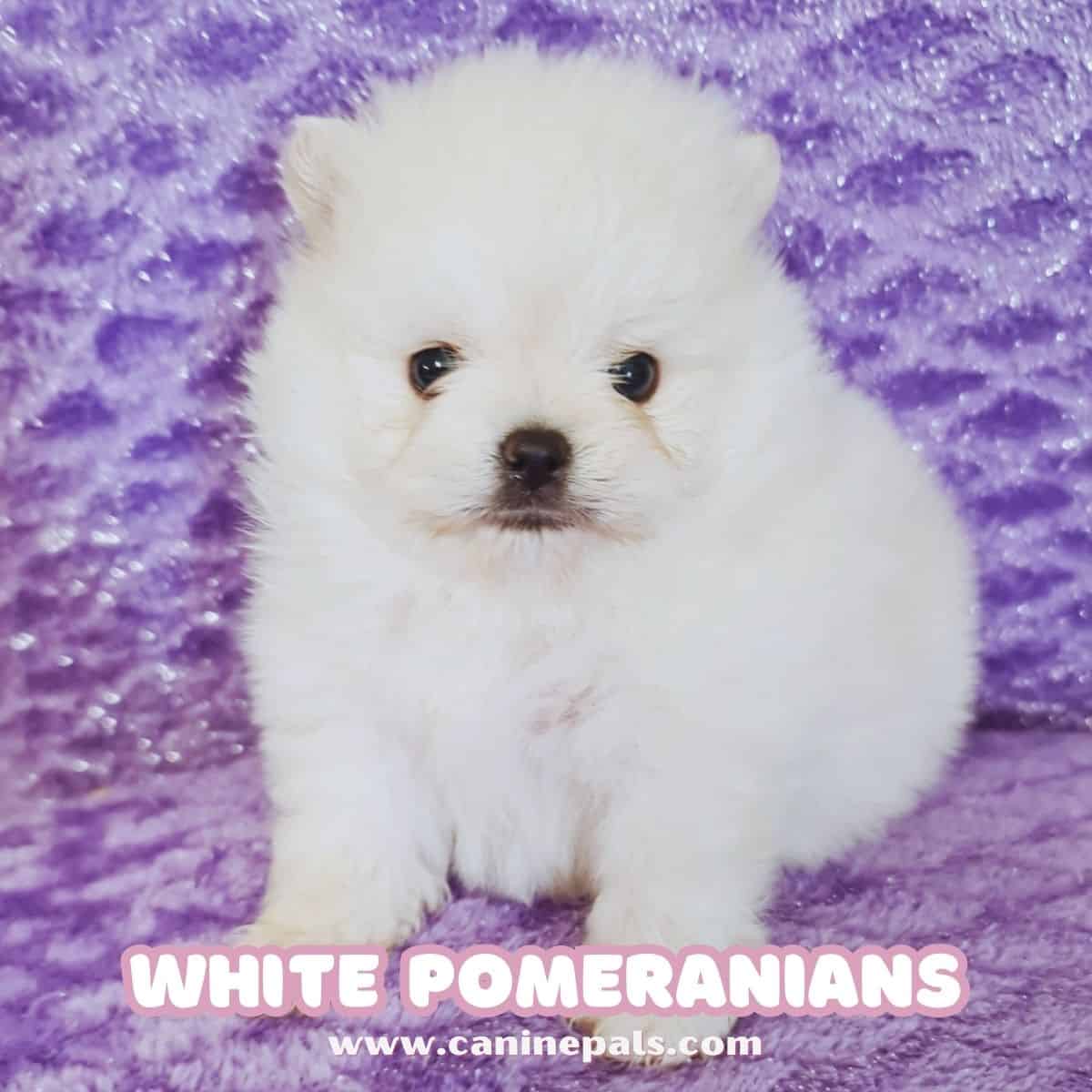
White Pomeranian Conclusion
Owning a white Pomeranian is not without its fair share of responsibility. Pomeranian owners must be dedicated to properly training and socializing the pups and providing regular grooming and veterinary care.
The breed will bring any family plenty of goofy antics, love, and companionship for years to come — making it the perfect choice for those hoping to welcome a new canine friend into their home. Of course, when choosing any pet companion, prospective owners should never forget that such a commitment requires dedication and patience on behalf of the pet parent.
With consistent effort invested into your furry pal, you can ensure that a white Pomeranian brightens your life with its loving and loyal personality.
Copyright CaninePals.Com. All Rights Reserved.
References and Further Reading:
- Official Standard of the Pomeranian (AKC). American Kennel Club, 2011.
- Official English Kennel Club Pomeranian Breed Standard, 2017.
- Kimbering Pomeranians “1891-1991”.
- Denise Leo, The Pomeranian Handbook.
- L.Ives, Show Pomeranians.
- L.Ziegler Spirer & H.F. Spirer, This is the Pomeranian.
- FEDERATION CYNOLOGIQUE INTERNATIONALE (FCI) German Spitz, including Keeshond and Pomeranian Breed Standards. PDF file.
The Pomeranian Handbook by Denise Leo
